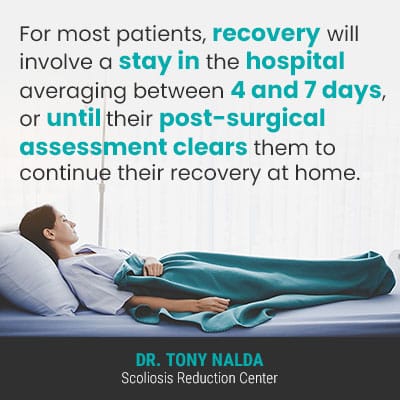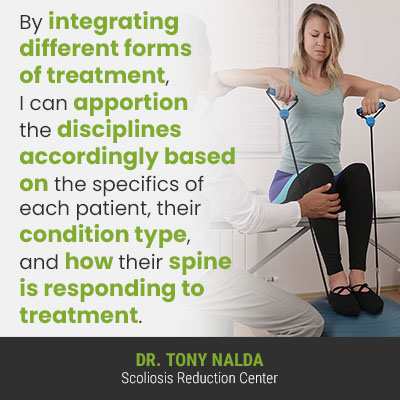Scoliosis is a condition whose very nature necessitates a customized treatment approach because there are multiple condition types and severity levels, each with their unique treatment needs. Continue reading to learn more about effective scoliosis treatment options, both surgical and nonsurgical.
Scoliosis surgery has the end goal of stopping progression, but that’s not the same as working towards corrective results. The answer to recovery timeframes will be case-specific, and spinal fusion alternatives involve a proactive and conservative treatment approach.
Let’s start our discussion of scoliosis surgery with a brief introduction to the condition itself for a better understanding of how scoliosis surgery affects the spine in terms of health and function.
What is Scoliosis?
Being diagnosed with scoliosis means an unnatural sideways spinal curve has developed, with rotation and a minimum Cobb angle measurement of 10 degrees.
The rotational element makes it a 3-dimensional condition, meaning it doesn’t just bend unnaturally to the side, but also twists from back to front, front to back.
The Cobb angle is known as the orthopedic gold standard in the assessment of scoliosis and classifies conditions on a severity scale of mild to moderate and severe to very severe:
- Mild scoliosis: Cobb angle measurement of between 10 and 25 degrees
- Moderate scoliosis: Cobb angle measurement of between 25 and 40 degrees
- Severe scoliosis: Cobb angle measurement of 40+ degrees
- Very-severe scoliosis: Cobb angle measurement of 80+ degrees
A patient’s Cobb angle is measured during X-ray and involves drawing intersecting lines from the tops and bottoms of the most-tilted vertebrae at the apex of the curvature, and the resulting angle is measured in degrees.
The higher the Cobb angle, the more out of alignment the spine is, which is an important factor in crafting effective and customized treatment plans.
Now, as mentioned, there are different types of scoliosis. However, the most prevalent form is adolescent idiopathic scoliosis (AIS), diagnosed between the ages of 10 and 18, so this is the condition type we’ll focus on in our discussion of scoliosis surgery.
An important condition feature, particularly in the context of scoliosis surgery, is that it’s progressive: meaning it’s in its nature to worsen over time, particularly if left untreated, or not treated proactively.
So what exactly does the process of scoliosis surgery involve?
What is Scoliosis Surgery?
More accurately known as spinal fusion, scoliosis surgery has the end goal of stopping progression, and while there are no guarantees it will do so, it involves the fusing together of the most-tilted vertebrae of the curve into one solid bone.
There are different types of spinal fusion, but most involve attaching rods to the spine with screws that hold the spine in place while the fusion site heals.
The rods will be attached to the spine forever, and as the most-tilted vertebrae are fused together, this eliminates movement (progression) in the fused section of the spine.
The issue with this approach is that many patients experience a significant loss in spinal flexibility and range of motion, leading to activity restrictions and greatly impacting the quality of life.
When it comes to how long it takes to recover from spinal fusion, that will depend on a number of factors that vary from patient to patient.
Scoliosis Surgery Recovery Time
Spinal fusion is a costly, lengthy, and invasive procedure that, like all surgeries, comes with its share of risks and potential side effects.
When it comes to recovery time, each patient will heal at their own pace and depend on a number of factors including patient age and overall health, condition severity, type, the number of vertebrae fused, and whether or not there were any complications during the procedure.

For most patients, recovery will involve a stay in the hospital averaging between 4 and 7 days, or until their post-surgical assessment clears them to continue their recovery at home.
Recovery will involve pain medications that will be reduced during the weeks following surgery, with the goal of being medication-free within six weeks, and activity restrictions such as no lifting, bending or twisting motions.
Most commonly, patients receive their first check-up within two weeks of the surgery, and activity restrictions and medication will be adjusted accordingly at that point, based on how the patient and their spine are healing.
In most cases, patients are cleared for regular activity within 4 to 6 weeks post-surgery, as long as no complications have developed, and their treatment provider clears them.
So, scoliosis surgery recovery time in adolescents, barring any unforeseen complications, tends to fall within the 2-to-6-week window. When the initial activity restrictions are lifted, and scoliosis recovery time, adults will follow along the same estimates, but tend to involve longer stays in hospital and lengthier activity restrictions due to age and overall health slowing recovery.
The cost of living with a fused spine can involve a significant loss in spinal flexibility and range of motion, which can cause permanent activity restrictions, not to mention an increased risk of spinal injury and how living with a fused spine affects patient’s on a psychological level.
While spinal fusion has its place in scoliosis treatment, what I want patients, and their families, to be aware of is that there are other treatment options available: nonsurgical treatment options with proven results.
Scoliosis Surgery Alternatives
There are two main scoliosis treatment approaches for patients to choose between. Once a diagnosis of scoliosis is given, the most important decision is how to treat it because as an incurable condition, how it’s responded to will have far-reaching effects.
The traditional treatment approach has been in place for many years, but despite our growing understanding of the condition and how it responds to treatment, it has changed little over those years, still funneling patients towards spinal fusion surgery.
A modern approach known as conservative, functional, and/or chiropractic-centered is what patients of the Scoliosis Reduction Center® benefit from, and this approach strives to achieve corrective results on a structural level.
The issue I have with traditional treatment is that while a condition is mild, they solely watch and wait for signs of further progression, but as a progressive condition, we know that virtually every case is going to progress at some point, so valuable treatment time is being wasted.
In addition, as we know that growth and development are the condition’s main trigger for progression, adolescents are at risk for rapid-phase progression because of the stage of puberty marked by rapid and unpredictable growth spurts.
While watching and waiting, an adolescent can have a large growth spurt, progress significantly, and then be funneled towards more-invasive forms of treatment.
While there are never treatment guarantees, with early detection and application of proactive treatment applied as close to the time of diagnosis as possible, there are fewer limits to what we can achieve. It’s far simpler to treat scoliosis while it’s mild, before progression and spinal rigidity have increased, and prior to the body having ample time to adjust to the unnatural spinal curve’s presence.
So what exactly does the non-surgical treatment of scoliosis involve?
Nonsurgical Scoliosis Treatment
Here at the Center, my main goal of treatment is to preserve as much of the spine’s natural function as possible, and by this, I mean its natural flexibility, strength, and range of motion.
I also want to help patients avoid the hardships associated with increasing condition severity; being proactive and working to stay ahead of the condition’s progressive nature by counteracting it with different treatment modalities can impact it on multiple levels.

By integrating different forms of treatment, I can apportion the disciplines accordingly based on the specifics of each patient, their condition type, and how their spine is responding to treatment.
Through condition-specific chiropractic care, in-office therapy, custom-prescribed home exercises, and corrective bracing, I can work towards, first and foremost, impacting scoliosis on a structural level: of key importance because scoliosis is a structural condition.
Through a series of chiropractic techniques and precise manual adjustments, I can adjust the position of the most-tilted vertebrae back into alignment with the rest of the spine for corrective results, and in-office therapy and custom-prescribed home exercises can help sustain those results.
Through the application of scoliosis-specific exercises (SSEs) and stretches, I can help patients increase their core strength so the muscles surrounding the spine can provide it with optimal support, stabilization, and pain management by keeping the muscles as strong and loose as possible.
In addition, SSEs can also activate certain areas of the brain for improved brain-body communication, postural remodeling, and better body positioning.
When it comes to scoliosis bracing, this can be an effective means of helping push the spine into a corrective position, particularly for the treatment of young patients whose spines are still growing.
To meet my patients’ bracing needs, I favor the modern ScoliBrace that represents the culmination of what we’ve learned about the condition and bracing as a treatment option over the years.
Unlike traditional bracing that works by squeezing the spine unnaturally, which is known to weaken it, the ultra-corrective ScoliBrace pushes the spine into a corrective position while addressing the condition’s true 3-dimensional nature.
When combined with other effective and proactive forms of treatment, corrective bracing can help augment corrective treatment results, helping patients avoid the need for invasive surgery by preventing increasing condition severity proactively.
Commonly Asked Questions
Is Scoliosis Surgery Painful?
Scoliosis surgery is a type of spinal fusion that commonly involves fusing the curve’s most-tilted vertebrae, at its apex, into one solid bone, and this is done to eliminate movement (progression) in the fused section.
While not all cases of scoliosis require surgery, many patients on the path of traditional treatment are going to be funneled towards spinal fusion surgery, and this involves fusing the curve’s most-tilted vertebrae into one solid bone so they can’t become more unnaturally-tilted over time.
Commonly, rods are attached to the spine with pedicle screws to hold it in place, and this is contrary to the spine’s movement-based design; this is why the procedure, although capable of straightening a crooked spine, can cause additional back pain.
Scoliosis Surgery and Pain
Scoliosis surgery can cause increased levels of back pain, particularly at the fusion site.
Spinal fusion also involves the removal of intervertebral discs that sit between adjacent vertebrae being fused, and the spinal discs perform many important functions: giving the spine structure, flexibility, acting as its shock absorbers, and providing cushioning to prevent friction during movement.
Where the spine is fused will be excessively stiff, and this can cause increased pain, and in addition, a spine that’s fused is one that’s not going to be as strong or flexible as it once was.
The spine is also supported by its surrounding muscles, and muscle pain can be an issue as well.
A spine that’s fused is fused so there is no movement in the vertebrae, meaning they can’t become more tilted over time, but this can mean the spine loses its flexibility and range of motion, and this can mean a stiff and painful back.
Not everyone will experience increased levels of pain following spinal fusion, but it is a common effect so should be considered carefully.
Factors that affect how a person responds to spinal fusion can include patient age and overall health, condition severity, and the number of vertebrae fused.
Some people maintain enough flexibility above and below the fused section to not feel increased pain levels, but others, particularly those whose fusions involve more vertebrae, tend to find their scoliosis surgery has made their back more painful.
How Long Does Pain Last After Scoliosis Surgery?
Every patient responds to spinal fusion differently, and the days immediately following the procedure are spent in hospital to monitor for how the patient is responding, signs of infection, and pain management.
In general, the goal is to wean patients off their pain medications as soon as possible, but depending on a patient’s pain level, this can vary; most patients are fully off their pain meds within a two weeks to a month.
But the important thing to remember with spinal fusion is that there are long-term effects, one of which can be a back that’s stiff and painful.
Fortunately, many cases of scoliosis don’t require surgery, and non-surgical treatment can preserve as much of the psine’s natural strength, flexibility, and function as possible.
Conclusion
When it comes to scoliosis surgery recovery timeframes and surgery alternatives, we’re talking about how the average adolescent responds to the procedure.
While each case is unique, on average, and barring any complications, young patients can be cleared to return home within a week of their surgery to continue recovery at home.
Pain medications will be reduced accordingly, with most adolescents being medication-free within six weeks of the procedure.
Activity restrictions immediately following the surgery will include lifting, bending, and twisting motions that can increase pain and strain the spine; adolescents who are healing well can generally return to normal activity levels within 3 months of having the spinal fusion.
While scoliosis surgery has its place in treatment, I want to empower patients with the knowledge that there are surgery alternatives that tend to be safer, less costly and invasive, have proven results, and are known to preserve more of the spine’s natural function.
Here at the Scoliosis Reduction Center®, I spent a lot of time discussing the different treatment approaches and options with patients, and their families, to ensure their treatment expectations are aligned with the reality of their potential outcomes.




